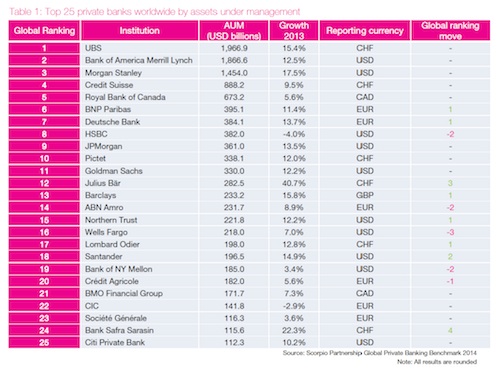WM Market Reports
Global Wealth Managers Log Buoyant AuM Growth; "Alarm Bell" On Margins - Scorpio

An annual benchmark of the world's wealth management industry shows they held more assets last year and raised their profits. UBS remains number one. Cost/income ratios, meanwhile, have actually risen.
The world’s wealth management industry saw profits rise last year
although cost/income ratios widened in the face of new rules,
while Switzerland’s UBS held its spot as the world’s largest
player in the sector, a report by Scorpio
Partnership shows. The report also highlighted how American
firms have found it more profitable to focus on a “stay at home”
strategy.
Examining 25 of the world’s largest wealth managers in its Global
Private Banking Benchmark 2014 report, it found managers logged
an average rise of 11.3 per cent in assets under management last
year. The top 25 firms oversee over 78 per cent of industry AuM,
which is a one per cent rise from 2012, suggesting further
industry consolidation at work.
AuM at UBS rose last year by 15.4 per cent to stand at $1.966.9
trillion, followed in second place (unchanged from 2012) by Bank
of America Merrill Lynch, with AuM rising 12.5 per cent, at
$1.866.6 trillion, and in third spot, by Morgan Stanley, with a
rise of 17.5 per cent in AuM to $1.454 trillion, the report said.

To register interest in obtaining a copy of the report
in full with your WealthBriefing discount, click here.
Up and down
Among the notable changes in the rankings for 2013 were rises by
France’s BNP Paribas and Germany’s Deutsche Bank, while Hong
Kong/London-listed HSBC slipped from sixth to eighth place.
Scorpio said that HSBC’s decline in AuM “would appear to be due
to its ongoing strategy of pulling out of non-core markets”. On
the other side of the coin, Zurich-listed Julius Baer, which is
taking over non-US wealth management assets of Bank of America
Merrill Lynch, has seen its assets surge 40.7 per cent, the
report said. (The report would have been issued prior to the
recent heavy fine on BNP Paribas by the US authorities regarding
sanctions violations.)
Across the wider industry figures for 200 benchmark banks,
Scorpio said that AuM growth has been strong, at 19.7 per cent,
more than double the growth rate seen in 2012. This means the
industry as a whole oversees a total of $20.3 trillion of high
net worth money, up from $18.5 trillion a year before.
Some of these gains have been driven by rises in markets, as well
as net new inflows. At the benchmark banks, net new inflows
averaged $1.8 billion.
Net new money also drove income growth; wealth managers saw an
average rise of 10.9 per cent in income for 2013.
Margins
In a world of rising regulatory costs – with no immediate end in
sight – private banks have had to adapt; the cost/income ratio
across the sector was 83 per cent in 2013, up from 80 per cent in
2012. In spite of that rise,, net new money figures meant
profitability nudged up 1.7 per cent last year, although not as
fast as the 5.3 per cent rise in 2012.
“This year’s results highlight major structural changes taking
place in global wealth management,” Seb Dovey, managing partner
at Scorpio, said in the report. “Overall, key growth indicators
are positive but efficiency averages are not yet improving, which
is an alarm bell to consider by many in the corridors of power,”
he added.
Bringing it all back home
One feature of the report is noting how US firms in particular
have, in certain cases, disposed of non-domestic business to
focus on home markets. Both Bank of America and Morgan Stanley
have, for example, spun off some of their non-domestic business
(as previously mentioned, BoA has sold its international wealth
business of Merrill Lynch to Julius Baer.)
As a result of such behaviour, Scorpio has brought out a new
ranking for leading US wealth managers, with BoA Merrill Lynch in
top spot, followed by Morgan Stanley; JP Morgan; Goldman Sachs;
Northern Trust; Wells Fargo; BNY Mellon, and Citi Private Bank.